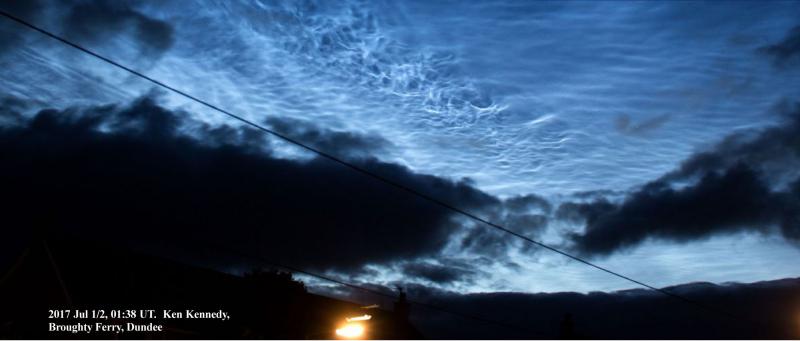Noctilucent cloud over Britain & Western Europe, 2017
2019 March 24

Introduction
Since the Aeronomy of Ice in the Mesosphere (AIM) satellite was launched by NASA in 2007, ground-based observers of NLC had an indication as to when ice was first forming in the mesosphere. In past years, this was identified by the Cloud Imaging and Particle Size (CIPS) instrument on board AIM: ground-based sightings of NLC could usually be expected within a few days of ice appearing on images taken by CIPS. However, following the NLC season in the Southern Hemisphere (ending in 2017 February), alterations to
the AIM software were made to account for orbital changes. This meant that data from the satellite were unavailable for most of the 2017 NLC season. Observers were obliged to return to the methods of pre-2007 years, when the only way of determining when the NLC season had started was by confirmed sightings from observers at two or more locations. In the past, individual observers have produced early unconfirmed reports, in some cases significantly before a consensus was reached using a number of sightings.
Solar activity continued to decline in 2017 and by December, the percentage of spotless days reached 28%, compared to 9% for the whole of 2016. As has been noted previously, declining solar activity has tended to coincide with an increase in NLC frequency and this initially seemed to be the case in 2017, as the frequency was higher than that in 2016. However, looking at the previous eight years, there was not as much variation in NLC frequency as there had been prior to this; the mean number of nights on which NLC was reported is 55 while that of 2017 was 54. This period took us through a solar maximum in 2014, but it should be remembered that Solar Cycle 24 was the quietest since Cycle 14 (1902-’13) and this may account for the relatively high frequency of NLC through solar maximum and afterwards.
A summary of observations received from the 2017 season is presented in Table 2, which includes a small number sent to the author by observers in the USA and Canada….(continued)
(Login or click above to view the full illustrated article in PDF format)
| The British Astronomical Association supports amateur astronomers around the UK and the rest of the world. Find out more about the BAA or join us. |
